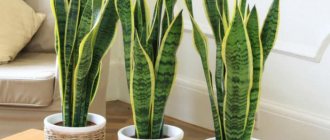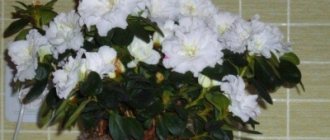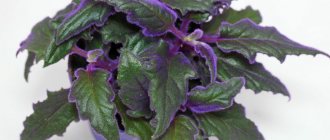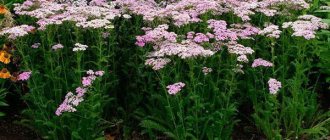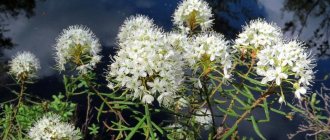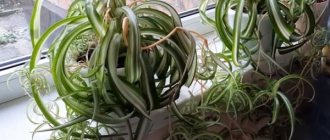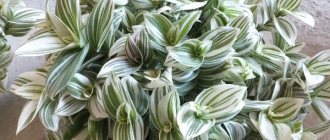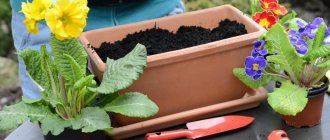Syrian tree hibiscus belongs to the Malvaceae family, is a beautiful exotic plant that is successfully grown both indoors and in the garden.
In total there are about 300 different varieties of Syrian rose .
The perennial in its natural habitat (Indonesia, China) prefers a subtropical climate, but adapts well to our difficult conditions.
It can be found in the southern regions of Russia and in the Moscow region, on the Crimean Peninsula, in Belarus and Ukraine .
Appearance of Syrian hibiscus
Syrian hibiscus (Hibiscus) is a plant from the Malvaceae family; its second name is garden (street) rose or Sharon. Syrian hibiscus (you will see the photo below) is a tree-like shrub with a height of 2 to 6 meters, depending on the variety. The stem is thick, has a tree-like shape, the branches are erect, not branching.
The flower has green, ovoid, medium-sized leaves with jagged edges. Hibiscus blooms with beautiful single simple and double flowers. Flowers can be of different colors: from white to crimson, sometimes bicolor.
Plant varieties:
- Brabant is a large hibiscus that reaches a height of 2 m and a width of 1.5 m. It blooms with large, densely double flowers with a diameter of 15 cm. It has a lilac-red color with a purple tint.
- Diana is a bush hibiscus up to 2 m with a large and simple flower. It has a white flower with wavy petals.
- Vayelit Ilar Double is an upright shrub, maximum height 1.3 m. It blooms with powerful double or semi-double flowers of bluish-violet color with burgundy streaks at the center.
- Pink Giant is a tall plant with large single pink flowers with a red-burgundy center.
- Carneus Plenus is a shrub with flexible stems, 1.5 to 2 m in height. The inflorescences reach 10 cm in diameter, painted in a soft pink color with a purple spot at the core.
- Red Heart is a fairly tall shrub with semi-double white flowers edged with burgundy at the center.
- Pink Chiffon is a hibiscus up to 2 meters high with large, densely double inflorescences. The color of the flowers is creamy pink with streaks around the center.
- Blue Chiffon is a rare and very beautiful shrub. Hibiscus Syrian blue chiffon blooms with blue flowers with a double center.
- Hybrid - obtained by crossing bright red, holly and swamp hibiscus. This is a herbaceous and perennial plant variety that produces very beautiful and large flowers during flowering.
Application in landscape design
The Syrian rose is a wonderful garden decoration. As I like to say, quoting a classic, this is “a holiday that is always with you.”
Hibiscus is an excellent tapeworm; it can be planted in the most visible place - in the center of a flower bed, in the patio, at the entrance to the house. Fits well into various compositions with thujas, spruces and other conifers. When planting hibiscus for a hedge, do not forget that it grows quite quickly and the distance between plants should be at least 1 m.
Hibiscus Duc de Brabant has a beautiful proportional crown with a height of about 1.2 m. In early - mid-July every year a small miracle occurs - the hibiscus blooms. Flowering continues for a long time, somewhere until the end of September, and its peak occurs at the end of July. At this time, the entire bush is covered with flowers - an extraordinary sight! Try planting it in your garden, you won’t regret it.
Where and how does it grow
Since Syrian hibiscus is a tropical plant, growing it in the garden will take a lot of effort and patience. The plant is susceptible to temperature changes. Planting young seedlings is possible only after spring frosts have stopped and the ground has warmed to 15 degrees.
You need to choose a place for hibiscus that is spacious, open, well lit, and without drafts. The soil should be very nutritious, rich in humus and drained, and its acidity should be neutral or slightly low.
Recommendations
- "Plant List: A Working List of All Plant Species." Retrieved April 8, 2014.
- " Hibiscus Syrian
L."
Plants of the world online
. Royal Botanic Gardens, Kew. Retrieved 2018-07-29. - Lawton, B. 2004. Hibiscus - a hardy and tropical plant for the garden. Timber Press, Portland, Oregon
- Walker, J. 1999. Hibiscus. Cassel, London, England.
- Alice M. Coates, Garden Shrubs and Their Stories
(1964) 1992,
sv
"Hibiscus". - " Syrian hibiscus
." Natural Resources Conservation Service PLANTS Database. USDA. Retrieved January 20, 2016. - "BSBI List 2007". Botanical Society of Great Britain and Ireland. Archived from the original (XLS) on 01/25/2015. Retrieved 2014-10-17.
- https://www.hort.uconn.edu/plants/detail.php?pid=204
- RHS AZ Encyclopedia of Garden Plants
. United Kingdom: Dorling Kindersley. 2008. p. 1136. ISBN 978-1405332965. - "Hibiscus Syrian 'Notwoodtwo' WHITE CHIFFON - plant search." Missouribotanicalgarden.org. Np, 2016. Web. April 21, 2017.
- plantfacts.osu.edu/pdf/0247-539.pdf. Np, 2022. Web. April 21, 2017.
- ^ a b
Buchan, Ursula. "Syrian Hibiscus: how to grow." Telegraph. Retrieved November 28, 2022. - plantfacts.osu.edu/pdf/0247-539.pdf. Np, 2022. Web. April 21, 2017.
- Ulcers on trees: various. 1st ed. College of Agriculture and Life Sciences, Cornell University, 2015. Web. April 21, 2017.
- "AGM Plants - Ornamental" (PDF). Royal Horticultural Society. July 2022. p. 48. Retrieved March 3, 2022.
- "RHS Plantfinder - Hibiscus Syrian Blue Chiffon
= 'Notwood3′'." Retrieved November 28, 2022. - "RHS Plant Selector - Hibiscus Syrian
'Diana'." Retrieved August 23, 2022. - 'RHS Plant Selector - Hibiscus Syrian
Hamabo'. Retrieved August 23, 2022. - 'RHS Plant Selector - Hibiscus Syrian Lavender Chiffon
Notwoodone'. Retrieved August 23, 2022. - "RHS Plant Selector - Hibiscus Syrian
'Mihani'." Retrieved August 23, 2022. - "RHS Plant Selector - Syrian Hibiscus
'Oiseau Bleu'." Retrieved August 23, 2022. - "RHS Plant Selector - Hibiscus Syrian
'Red Heart'." Retrieved August 23, 2022. - "RHS Plantfinder - Hibiscus Syrian White Chiffon
= 'Notwoodtwo'." Retrieved November 28, 2022. - "RHS Plant Selector - Hibiscus Syrian
William R. Smith'". Retrieved August 23, 2022. - "RHS Plant Selector - Hibiscus Syrian
'Woodbridge'." Retrieved August 23, 2022. - https://www.korea.net/NewsFocus/Culture/view?articleId=75126
- https://www.youtube.com/watch?v=cmtjuG5nPgc
- "Korean Rose"
- Parkinson, Paradisi in Sole Paradisus Terrestris
, 1629. - Quoted in Coats 1992.
- Anne Leighton, American Gardens in the Eighteenth Century: For Use or Pleasure
(1976:429).
Benefit
Syrian hibiscus is a wonderful ornamental plant that, with proper care, will grow and delight you for up to 20 years. This plant is ideally suited for creating hedges, border plantings, group compositions, for decorating artificial reservoirs, and masking design flaws.
Syrian hibiscus (indoor plants) can be safely grown at home; it blooms very beautifully, will decorate your room and please the eye.
Syrian hibiscus: planting and care
Planting hibiscus
In order for the plant to take root well and grow properly, the following rules should be observed when planting:
- Loosen the soil and then dig a hole that will be approximately twice the size of the hibiscus root system.
- The bottom of the pit must be filled with small stones; broken bricks can be used.
- A small part of the hole needs to be filled with a special mixture consisting of earth, sand and peat.
- After this, you can place the plant in the hole, slightly deepening the root system.
- Next, cover the plant with the remaining mixture and loosen it well.
- Immediately under the root you need to pour one bucket of water.
- Then you need to fill up the missing soil, which settled during watering, and form a tree trunk circle.
Plant care
In order for the plant to grow well, it must be watered regularly. But you need to water carefully so that the root system does not rot. It is necessary to water when the soil in the tree trunk circle has become dry. In the summer - from June to September, the bush must be fertilized, mineral mixtures must be rich in nitrogen and phosphorus, and closer to winter, potassium fertilizers must be added.
Pruning is required and should occur immediately after planting the hibiscus. It is necessary to trim all branches to three buds; there is no need to trim the trunk. Next, you should prune the bush twice a year, the first time in early spring, and the second time before wintering after the leaves fall.
The plant requires careful care in the fall before wintering. First you need to trim the dry branches, leaving a few centimeters. Next, you need to dig up the tree trunk circle, and lay a layer of dry grass and sawdust on top. It is better to cover the top with spruce branches or spunbond. Thanks to this preparation, hibiscus overwinters without problems.
Questions - answers
Is caring for Syrian hibiscus too difficult?
Hibiscus is an unpretentious and unpretentious plant. It does not require special maintenance conditions; a novice gardener can handle it quite well.
Frost resistance, which varieties require shelter for the winter?
In regions with cold winters, shelter construction requires all varieties of Syrian rose.
How bright and sunny should the lighting be?
The brighter the place for planting the Syrian rose is illuminated, the brighter and more abundant its flowering will be. Light shading is allowed during the midday heat, but in the morning and evening hours the plant should receive direct sunlight.
What colors can be combined with in the garden?
There is an excellent combination of hibiscus with almost any variety of roses. In addition, in appearance they will form a luxurious tandem. If you live in a fairly warm region, then plant several lavender bushes next to the hibiscus - this will not only give the garden aesthetic appeal, but will also protect the hibiscus from various pests.
Why doesn't Syrian hibiscus bloom?
If you planted a hibiscus in a bright, spacious area and care for it, as required by agricultural technology, but it nevertheless does not want to bloom, most likely the problem is a lack of phosphorus and boron. And if the shoots slow down their growth, then the problem is also a lack of nitrogen. Don’t forget to apply the fertilizers your hibiscus needs on time, and it will definitely bloom.
Why do the leaves turn yellow?
Hibiscus leaves turn yellow due to chlorosis, as well as in case of injury to the root system that the plant could receive during transplantation. If the hibiscus turns yellow due to the roots, then it is necessary to add Zircon or Kornevin to the water for irrigation (see instructions) and for spraying the leaves (three drops per half liter of water). Hibiscus leaves turn yellow as a result of insufficient watering during the hot, dry summer.
Why do the leaves fall?
If hibiscus leaves fall off in the fall, this is a natural process, but if this happens prematurely, then the problem arose either due to improper watering (insufficient or excessive), or the root of the plant is injured. For recommendations on what to do in these cases, see the previous sections.
Hibiscus propagation
Like many other shrubs, hibiscus reproduces in three ways:
- The first is propagation by seeds, for which you need to start preparing in winter. The seeds should first be soaked in humate, then spread on gauze and wrapped in polyethylene. When the first shoots appear, they are planted in the substrate to a depth of 5 mm.
- The second method is propagation by layering, which is carried out in the second half of March. Near the hibiscus you need to dig a two-finger groove, take one shoot from the bush and put it horizontally in it, cover it with earth. In the fall, when the cuttings have grown, they are planted in a permanent place.
- The third way is by cuttings. In spring, a 15 cm long shoot with four buds is cut off from the bush. The leaves are torn off, leaving only a few on top. The shoot is soaked and then planted vertically in a container with drainage, peat and substrate. When the root system gets stronger, it is necessary to transplant the plant into open ground.
Trimming
In order for the plant to be healthy and have a beautiful shape, pruning should be done in the spring. During this procedure, diseased and deformed branches should be removed, in place of which young shoots will form.
Note! If the plant is pruned for shape, it may not bloom or have a small number of flowers that year. This is due to the fact that the hibiscus spends all its energy on the formation of new shoots.
Pruning is also done to rejuvenate the plant. In this case, all dried branches are removed from the Syrian rose.
If the plant is affected by a disease, all affected areas should be removed along with some healthy tissue.
If the plant grows in a pot, then from time to time pruning of the root system is required. This is done in cases where the roots do not fit into the container.
